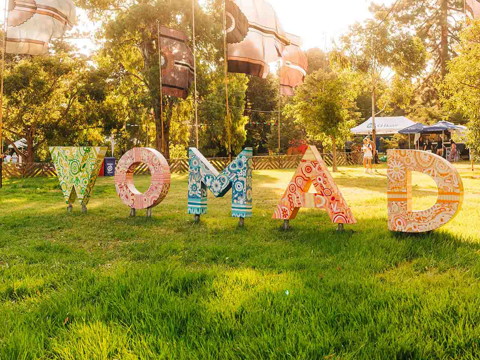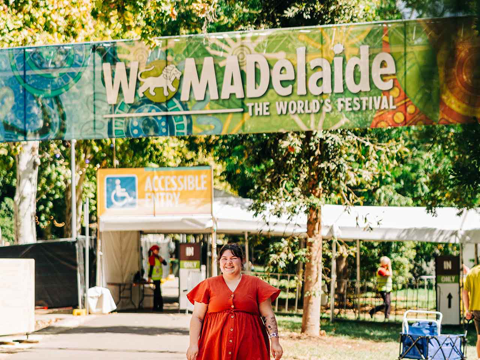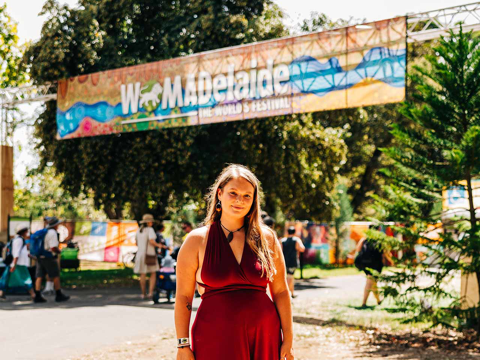Reconciliation Action Plan
View Reconciliation Action Plan
Since its inception, WOMADelaide has championed First Nations artists, with programs that have showcased artists and storytellers from across the country. Embracing the diverse cultural tapestry and artistic narratives of Australia's First Nations peoples, WOMADelaide strives to provide a platform for stories to be heard through music, arts, and dance, and play a pivotal role in fostering cultural understanding and appreciation amongst festival attendees.
WOMADelaide has consistently featured performances from many talented First Nations artists and groups, demonstrating a distinctive commitment to showcasing First Nations sounds and stories. Throughout the years this has enabled an increased visibility on the global stage and significantly contributed to the broader recognition and celebration of Australia's rich First Nations culture.
Since 1999, a Welcome to Country has opened the festival, led by Kaurna elders including Karl Telfer & Paitya Dance Group, followed by the late Stevie Goldsmith and Taikurtinna, then Uncle Stevie’s son, Jamie Goldsmith and Taikurtinna and, in more recent years, Ngangki Warra.
Each year, WOMADelaide incorporates educational initiatives and discussions that focus on First Nations issues. Through workshops and the Planet Talks series, the festival creates an environment where festivalgoers can engage with, and learn from, the profound cultural heritage of Australia’s First Nations communities.
This emphasis on cultural exchange and understanding has transformed WOMADelaide into an experience that transcends boundaries and builds bridges between communities.
Explore more about Kaurna culture with the City of Adelaide's map.
Commissioned Artworks
Since 2024, WOMADelaide has commissioned First Nations artists to reimagine the festival site.

WOMAD Letters
Our iconic WOMAD letters have a brand-new look featuring the commissioned artwork of Narangga and Ngarrindjeri artist, Cedric Varcoe. In 2024, Cedric adored the letters with symbolism representing people from all walks of life coming together and connecting with community in the true spirit of the festival.

Entrance By Sarah Bates
Welcoming festival-goers at the new entrance of WOMADelaide, this captivating artwork by Barkindji artist Sarah Bates weaves together the rich cultural heritage and vibrant present of Kaurna Country.
Born in Far West NSW, Barkindji artist Sarah Bates has spent the last 20 years residing on Kaurna Country. With ties to both NSW and SA, Sarah’s art is a reflection of her connection to country and the lands she has grown up on in Adelaide.
Each section of the piece shares a unique story: the first honors the pre-colonial and post-colonial history along the River Torrens (Karrawirra Parri), a vital artery for the Kaurna people; the middle celebrates the natural beauty and significance of the River Red Gums and mistletoe that thrive in Botanic Park, known as Tainmundilla in Kaurna, or mistletoe place; and the final section reflects on the space as it is today—a cherished cultural and recreational gathering place for all. Sarah’s vibrant color palette shines brightly against the park’s green backdrop, inviting everyone to step into the festival’s world of music, art, and cultural connection.

Entrance By Iteka Ukarla Sanderson-Bromley
Welcoming festival-goers to WOMADelaide is a stunning new entrance artwork by Iteka Ukarla Sanderson-Bromley, an Adnyamathanha, Narungga, and Wangkangurru Yarluyandi artist.
Intertwining the rich cultural roots of Kaurna Country with the lively spirit of WOMADelaide.
In the top section, Iteka honors Kaurna land and culture, representing the Adelaide hills, with linework taking you down to the river, setting the location of where WOMADelaide finds its home.
Concentric lines represent the land itself, embodying the spirit of Karrawirra Parri, the dotted shapes are representations of all different aspects of culture (language, ceremony, dance, art, hunting, plants, animals). They spread from the hills down to the river showing the interconnectedness on all elements of culture with each other and with the land, setting the tone for a celebration of culture, community, and creativity.
At the bottom of the banner are four unique circles, each circle representing different aspects of WOMADelaide. The stages and performers, the market stalls, the community, and the creativity. Each individual element that together creates WOMADelaide.
First Nations Programming
Presentations across the years have included:
Performers from Arnhem Land over the years have included Djuki Mala (2018), Gawurra (2017), Djalu Gurruwiwi (2015), Gupapuygnu Dancers (2006), Wildflower (2023) and Wildfire Manwurrk (2024).
Australian contemporary powerhouses such as Emily Wurramara (2025), 3% (2025), Bumpy (2024), Baker Boy (2022) A.B Original (2017 & 2022), Thelma Plum (2013 & 2019), Mo’Ju (2019 & 2024), Electric Fields (2017 & 2022), Barkaa (2022), King Stingray (2022) and Emma Donovan (2007, 2015 & 2022) have shared their music and unique and important stories.
1995, 1999, 2023 and 2025: Bangarra Dance Theatre, Australia’s premier First Nations contemporary dance company, have brought three extraordinary works to the WOMADelaide stages.
2020: The WOMADelaide x Northern Sound System Academy was established, with graduates MRLN x RKM (2021), Sonz of Serpent (2022), DEM MOB (2023) and Rob Edwards (2024) performing in the Academy showcases and subsequently being selected to perform on the festival stages.
2008, 2014 and 2022: Kutcha Edwards performed, most recently with graduates of the Centre for Aboriginal Studies in Music.
2001: Inma (The Rope Story) was developed by Aṉangu Pitjantjatjara elders as a means of refocussing young men taking risks with their lives and reinforcing their place in the land and the universe.
1992 - 2021: The late Archie Roach gave timeless performances at six WOMADelaide festivals, creating poignant journeys through the heart and soul of Australian storytelling and leaving an indelible mark on audiences and artists alike.
2019, 2025: Central Australian Aboriginal Women’s Choir performed German hymns and other sacred music in the traditional Western Arrarnta and Pitjantjatjara languages in an extraordinary meeting of cultures.
2017: The late Uncle Jack Charles, respected Aboriginal elder and unofficial ‘Godfather of Indigenous Theatre’, joined longtime friend Archie Roach in an extraordinary Artist in Conversation entitled Healing & Empowerment Through the Arts.
2012: Weaving the World saw Better World Arts and Aṉangu Pitjantjatjara Yankunytjatjara (APY) artists present weaving and sand art alongside Tenzin Choegyal and the Monks of Tibet.
2009 and 2012: The late Dr G Yunupingu transported audiences with his hauntingly beautiful voice and soulful melodies, leaving an unforgettable imprint of emotional resonance.
2009, 2010 and 2011: in partnership with Better World Arts, WOMADelaide commissioned the creation of 60 hand-painted original artworks in 2009, 2010 (Kungkarangkalpa in the Sky), and 2011 (Flags of the APY Lands). These were subsequently exhibited at WOMAD festivals in Adelaide, New Zealand, and the UK.
2008: The Black Arm Band created an extraordinary performance featuring a 32-piece 'super-band' of leading First Nations artists including Stephen Pigram, Archie Roach, Ruby Hunter, Lou Bennett, Joe Geia, and Kutcha Edwards. 17 Tiwi artists from Pwanga Womens Enterprise led screen-printing workshops for the local community before the festival and created fabric and garments live onsite at the festival.
2007: Nganampa Music saw artists from the APY Lands come together to undertake singer-songwriter workshops with Kev Carmody and Adelaide musician Dylan Woolcock; Tjanpi Desert Weavers, traditional weaving artists, joined forces with Adelaide contemporary textile artist Sandy Elverd for a series of cross-cultural workshops for the South Australian arts community and create woven baskets and large-scale sculptural works for exhibition at the festival.
1993: Yothu Yindi’s electrifying presence at the second WOMADelaide created a powerful and culturally significant musical experience that transcended time and connected with audiences.
1993: Mornington Island Dancers was established by Lardil elders to preserve the heritage and culture through stories and dances of the gulf region.





